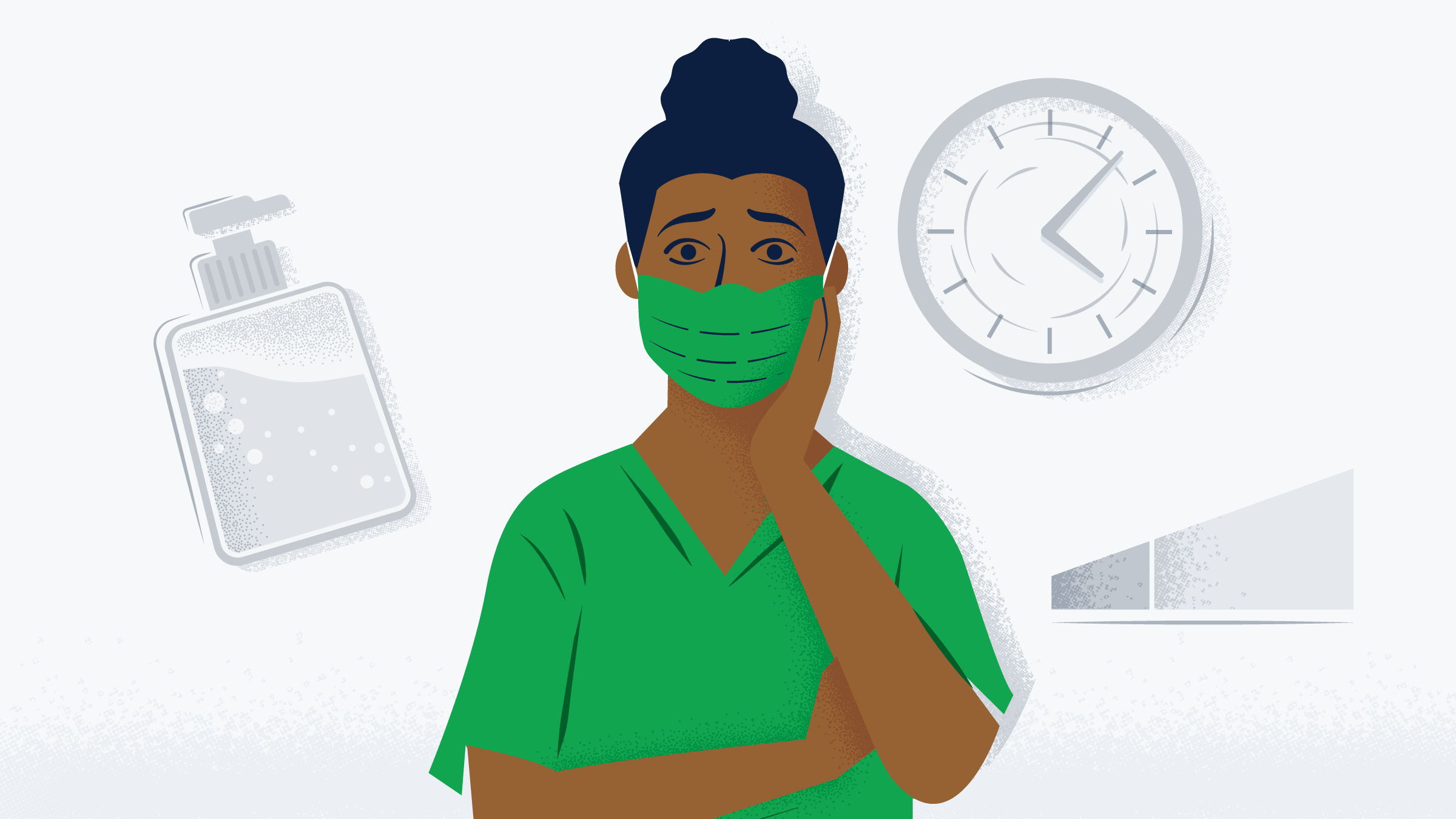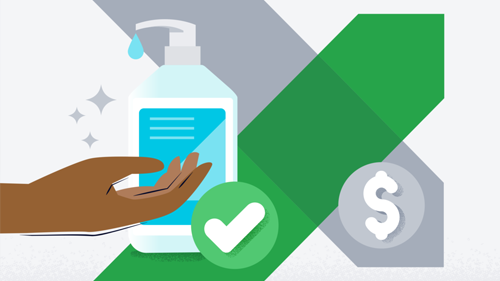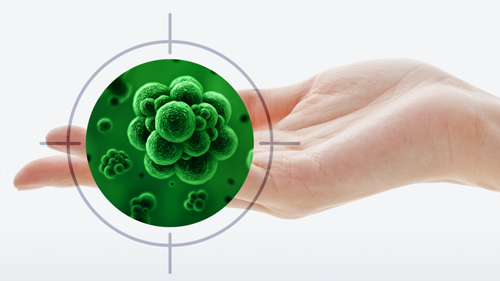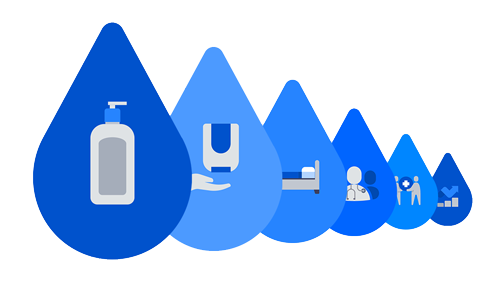Barriers to hand hygiene: 6 solutions to improving compliance
Resolve healthcare workers’ biggest issues, from dry hands to limited time.

Hand hygiene reduces the incidence of healthcare-associated infections (HAIs)—it’s the simplest and most important factor in preventing the spread of pathogens in healthcare settings. But achieving and sustaining high levels of compliance is a constant challenge, with caregiver rates hovering from 40 to 50%.1 Surely, compliance levels have stayed high due to safety precautions put in place during the COVID-19 pandemic, right? Think again.
A study of seven hospitals and 10 pediatric inpatient units in two children’s hospitals was conducted from January to May 2020 to examine hand hygiene compliance of healthcare workers during the pandemic. During this time, average hand hygiene rates increased from 46% to 56% in the months preceding pandemic-related school closures. This was followed by a 6% upward shift at the time school closures occurred. Hand hygiene rates remained over 60% for 4 weeks before declining to 54% at the end of the study period.2
Other hand hygiene studies conducted during the pandemic also have shown initial compliance increases and subsequent decreases.3 And that’s not all. Settings that have the highest need for proper hand hygiene, such as intensive care units, usually have the lowest compliance rates.
Surely, compliance levels have stayed high due to safety precautions put in place during the COVID-19 pandemic, right? Think again.
What can you do to overcome these challenges? Below are solutions to the most common barriers to hand hygiene compliance. You’ll also find links to recommended articles that take a more comprehensive look.
1
Barrier: Skin dryness and irritation
Solution: Use today’s innovative products that sanitize and moisturize hands, and are formulated for high-frequency use.
For example, consider alcohol-based sanitizers with moisturizers that are tested and approved to kill 99.99% of germs on hands while hydrating dry skin.
When evaluating hand hygiene products for potential use in healthcare facilities, purchasers should consider the relative efficacy of antiseptic agents against various pathogens and the acceptability of hand hygiene products by staff. Product acceptance can be affected by characteristics of the product such as its smell, consistency, color and the effect of skin irritation and dryness on hands.
“Product selection should include evaluation and feedback by the end users,” says Angela Zuick, Medline Director of Clinical Services. “Compliance goes up when caregivers are comfortable with the hand hygiene products provided.”
For more detail, read the articles Hand hygiene compliance: How moisturizing hand sanitizers can make a difference and Proper hand hygiene and skin health: How moisturizing helps prevent infection.
And don’t forget about exam gloves. An important part of hand hygiene, exam gloves with beneficial colloidal oatmeal coatings that soothe and restore moisture to skin will help keep caregivers’ hands healthy. Find out more by reading the article Exam gloves and infection control: A vital part of your hand hygiene strategy.
2
Barrier: Time required to perform hand hygiene before and after providing care
Solution: Use quick-drying alcohol-based formulas that don’t delay putting on gloves and tending to patients and residents.
Make these products available in wall-mounted dispensers close to the point of care. Provide tabletop pump bottles and personal-carry bottles when access to wall-mounted dispensers is not convenient.
In addition, unless a patient or resident is in a life-threatening situation, make hand hygiene part of the greeting when caregivers and other staff enter their room.
“We have to empower caregivers to say, ‘I’ll help you in a moment, but for your safety, I’m going to clean my hands first,’” says Zuick.
3
Barrier: Lack of access to hand hygiene supplies
Solution: Ensure you have hand hygiene delivery systems at or near every point of care.
Easy access is essential for acceptance and use of products.
“If you don’t have point-of-care access with a delivery system that’s reliable day in and day out, hand hygiene compliance by healthcare workers is going to be sub-optimal,” says Paul Alper, Medline Vice President of Patient Safety Innovation. “And it’s not just wall dispensers. It could be packets of wipes, canisters of wipes, tabletop pump bottles or personal-carry bottles.”
40 to 50%
is the average rate of hand hygiene compliance among healthcare workers1
4
Barrier: Lack of knowledge about guidelines, hand hygiene moments during patient care and risk of cross-contamination
Solution: Provide education and training materials on facility protocols, cross-contamination risks and the right technique at the right moment.
“You have to have learning systems that teach people when, why and how to perform hand hygiene, and that means education on indications for hand hygiene,” says Alper. “Caregivers might not realize that gloving is an indication for hand hygiene before and after.”
Another step to consider is using a handwashing learning kit that uses visible simulated germs to show the effectiveness of proper hand hygiene practices.
Take a deeper look by reading Hand hygiene: Science says it’s the first line of defense against HAIs and Hand hygiene in healthcare: Follow six essential elements to help keep people safe.
5
Barrier: Lack of awareness that hand hygiene compliance is low
Solution: Provide performance data to caregivers so they know how they’re doing.
Whether you use direct observation or an electronic hand hygiene monitoring system, you need to accurately measure compliance rates. From there you can look at the numbers, provide results to caregivers and develop an action plan for improvement.
“Feedback should be provided in a way that celebrates improvements and promotes constructive conversation,” says Zuick. “In other words, promote a positive environment, not a punitive one.”
For specifics on conducting direct observation and determining if electronic hand hygiene monitoring technology is right for your facility, read Measuring hand hygiene in healthcare: Steps for observing staff compliance and Should your facility adopt an electronic monitoring system for hand hygiene?
6
Barrier: Prioritizing hand hygiene and influencing people you don’t have authority over
Solution: Collaborate with colleagues and leadership to create a culture of safety.
“A culture of safety means leadership promotes accountability and a psychologically safe environment, where staff feel comfortable speaking up about safety lapses and encouraging peers, superiors and subordinates to follow proper hand hygiene,” says Alper.
For example, physicians and nursing assistants have low hand hygiene compliance. Any healthcare worker should be able to remind a doctor to perform hand hygiene without fear of reprisal.1
“It’s all in the approach,” says Zuick. “You can say, ‘The hand sanitizer is in the corner, doctor. I know it’s not easy to spot,’ or, ‘What size gloves do you take? I’ll grab a pair for you.’ That way, you hold the physician accountable without undermining the patient’s confidence in their care team.”
As you build your program, you may want to start by taking a risk assessment, as shown in Looking for ways to improve hand hygiene? And you can begin your hand hygiene strategy by referencing Hand hygiene compliance: Start with a simple checklist to create positive change. Finally, to show leadership the financial benefit of prioritizing hand hygiene, check out The business case for building your hand hygiene program: What you need to know.
Key takeaway
Hand hygiene compliance of healthcare workers is the simplest and most important way to reduce HAIs. Yet rates have stayed between 40 and 50%.1 Even compliance increases during the COVID-19 pandemic have been temporary. The only way to increase and sustain hand hygiene compliance is by understanding the obstacles and taking steps to address each one. Patient safety depends on it.
References:
- CDC. Hand hygiene in healthcare settings core presentation. 2002. Available at: https://www.cdc.gov/HandHygiene/download/hand_hygiene_core.pdf
- Moore, Lori; Robbins, Greg; Quinn, Jeff; and Arbogast, James. The impact of COVID-19 pandemic on hand hygiene performance in hospitals. American Journal of Infection Control, Volume 49, Issue 1, p30-33, January 1, 2021.
- Stangerup, Marie; Hansen, Marco; Hansen, Rosa; et al. Hand hygiene compliance among healthcare workers before and during the COVID-19 pandemic: A long-term follow-up study. American Journal of Infection Control, Volume 49, Issue 9, p1118-1122, September 1, 2021.
- CDC. Hand Hygiene in Healthcare Settings. Accessed February 4, 2022. Available at: Hand Hygiene in Healthcare Settings | CDC.




